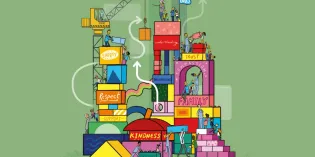These resources were published in May 2025 as part of our project to support children and young people's voice in their epilepsy care and service - find out more about this project and explore more resources in the related content box.
This page explores two dimensions of the Lundy model of participation - Audience and Influence. These prompt us to think about who needs to hear what children and young people are saying to make a difference and act on it.
Audience
When children, young people and their families have taken the time to explore their experience, express themselves and generate ideas for change, whether that is in their own care or about service provision, it is important that these messages reach the ‘right audience’. The right audience may be your team, their family and friends, schools, senior decision-makers, commissioners or directors of service depending on the issues raised.
If you are gaining feedback about a service or at a more strategic level it is very helpful to get buy-in from all the stakeholders early in the process, so they are receptive to the feedback from children and young people.
Map out with your team:
- Who can help make the change happen?
- What motivations might they have to listen to and act on the feedback from children and young people?
- Who else do the children, young people and families want to share their feedback and views with?
- How do children and young people and their families want their feedback to be shared with this audience?
Download the worksheets below: voting activity and audience planning activity.
Influence
This stage is key. The ultimate goal is to see change that improves that child or young person’s, or their families’ experience of epilepsy support, which means we need to act wherever possible on the feedback we receive. If we can’t take forward or act on the suggestions made, then it is still important to feedback and update children and young people on why.
Key things to think about are:
- Clear boundaries / expectations from the beginning. Be upfront about any limitations on decision-making, for example, budgetary restrictions or policies which might affect what can be done (for good reason). Also share what the limits are on staff resources. If you provide this information to children, young people and families from the outset then their proposals and thinking will be more informed and realistic.
- Making a clear commitment to act and follow through on some level. This may be about ensuring the feedback is shared in key forums, continuing the discussion about what change is feasible.
- Be a champion and advocate for the issues and ideas raised by children, young people and families in the spaces and forums that they cannot attend.
The four f’s of feedback!
Keeping children, young people and families informed about the process, progress and any outcomes is crucial for people to feel like their time has not been wasted, even if they don’t get the outcome they initially hoped for. The Lundy model lays out four F’s of feedback as a guideline for how this should be done.
- Full: provide comprehensive feedback to children and young people. Outline which of their views were accepted and which were not accepted and the reasons for these decisions. The feedback should also note who is implementing their views and what is happening next
- Friendly: feedback and responses should be in format and language they understand
- Fast: Six months is a long time for children! Try and give feedback quickly, even if it has to come in stages
- Followed up: ongoing updates (if relevant) and updates on actions.
Sharing and celebrating engagement
Finally, think about how will you reward, recognise, celebrate and share the input of children and young people. Some ideas from our groups are:
- Letters and cards of thanks
- Payment/vouchers for engagement (see NIHR guidance for payments in research and NCVO guidance for payments to volunteers)
- Certificates
- References
- Celebration meals or outings for the group.
- Sharing learning and findings through newsletters, twitter, emails to colleagues etc
- Holding a webinar, meeting or event to showcase and share the project
Case studies
Throughout the project, the projects involved have been keeping track of what they have done, what they learnt and capturing tips to share. You can read their case studies below which will give you ideas for your engagement hopes and aspirations too. Please share with us your journey by emailing and_us@rcpch.ac.uk.










